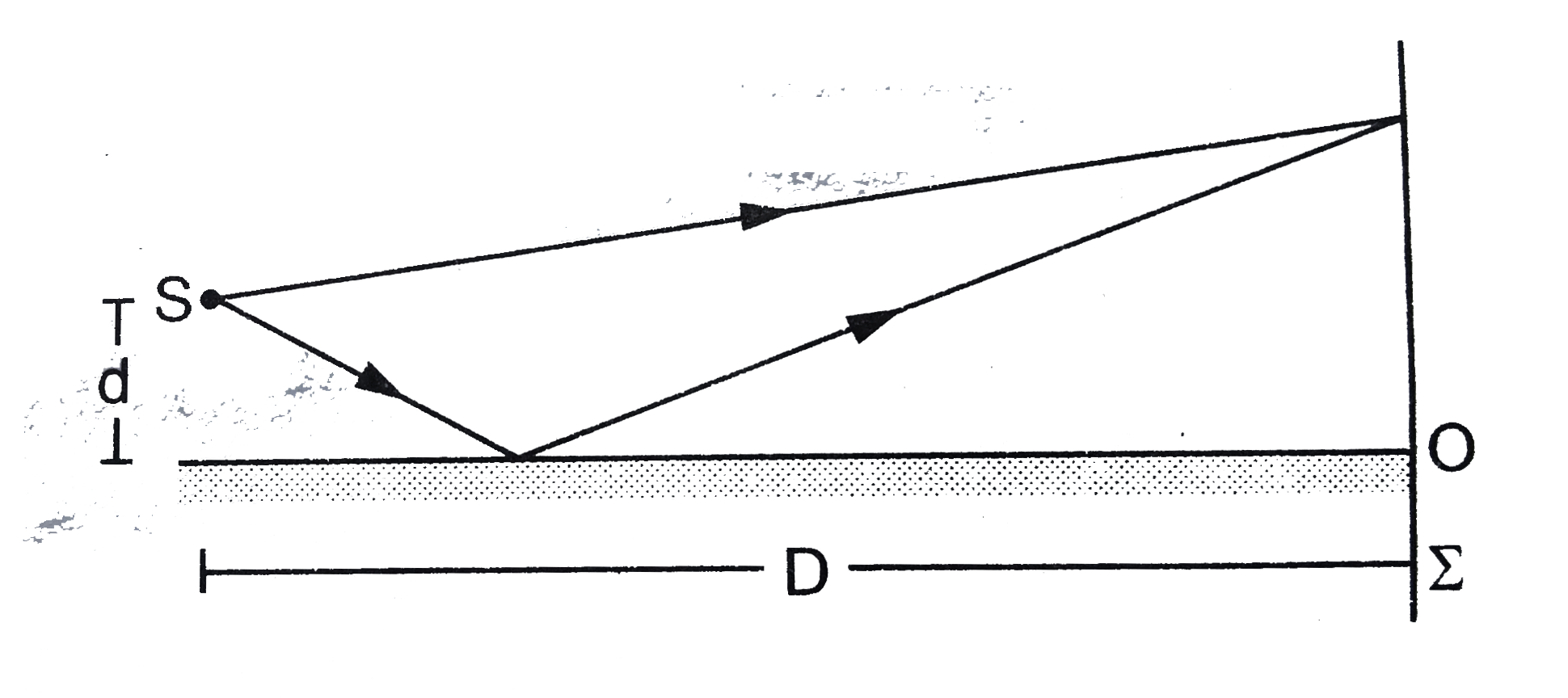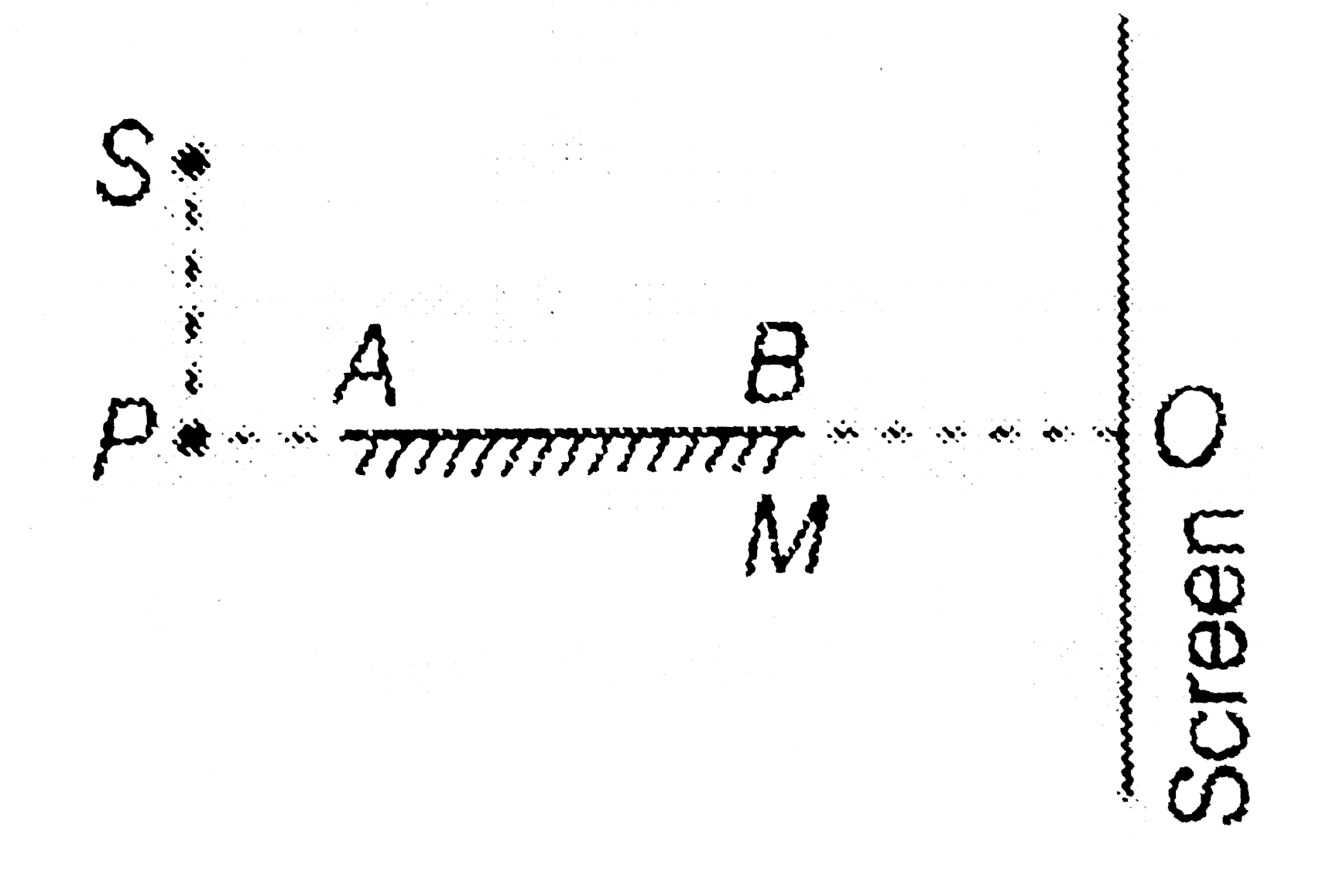A narrow slit S transmitting light of wavelength is placed a distance d above a large plane mirror as shown in figure. The light coming directly from the slit and that coming after the reflection interference at a screen placed at a distance LD from the slit. a. What will be the intensity at a point just above the mirror. i.e., just above O? b. At what distance from O does the first maximum occur?
? Solution in Gujrati
Solution in Gujrati
The correct Answer is:A, B, D
a. Since there is a phase difference of between direct light and reflecting light the intensity just above the mirror will be zero.ltbr> B. Here 2nd= equivalent slit seperationn
D=distance between slit and screen.
We know for bright fringe
But as thereis a phase reversal of
Topper's Solved these Questions
Similar Questions
A light wave can travel
05:41View SolutionA concave mirror having a radius of curvature 40 cm is placed in front of an illuminated point source at a distance of 30 cm from it. Find the location of the image.
04:49View SolutionAn alpha particle is projected vertically upward a speed of 3.0X104kms−1 in a region where a magnetic field of magnitude 1.0 T exists in the direction south to north. Find the magnetic force that acts on the a particle.
View SolutionA narrow slit S transmitting light of wavelength λ is placed a distance d above a large plane mirror as shown in figure. The light coming directly from the slit and that coming after the reflection interference at a screen ∑ placed at a distance LD from the slit. a. What will be the intensity at a point just above the mirror. i.e., just above O? b. At what distance from O does the first maximum occur?
? 03:07View Solution
03:07View SolutionA long narrow horizontal slit is placed 1 mm above a horizontal plane mirror. The interference between the light coming directly from the slit and that after reflection is seen on a screen 1.0 in away from the slit, Find the fringe-width if the light used has a wavelength of 700 nm.
02:09View SolutionA double slit S1−S−2 is illuminated by a coherent light of wavelength λ. The slits are separated by a distance d. A plane mirror is placed in front of the double slit at a distance D1, from it and a screen ∑ is placed behind the double slit at a distance D2, from it . The screen ∑ receives only the light reflected by the mirror. Find the fringe-width of the interference pattern on the screen.
 View Solution
View SolutionA long horizontal slit is placed 1 mm above a horizontal plane mirror. The interference between the light coming directly from the slit and the after reflection is seen on a screen 1 m away from the slit. If the mirror reflects only 64% of the light falling on it, the ratio of the maximum to the minimum intensity in the interference pattern observed on the screen is
View SolutionA long narrow horizontal slit lies 1 mm above a plane mirror. The interference pattern produced by the slit and its and its image is viewed on a screen sum distance 1m from the slit. The wavelength of light is 600 nm . Then the distance of the first maxima above the mirror is equal to (d lt lt D) :
View SolutionIn a Lloyds's mirror experiment as narraow slit S iransmitting a light of wavelength lambda is placed 3 mm above a small plane mirror ( as shown). The light coming directly from the the slit and that coming after the reflection interfere on a screen placed at a distance of 90 cm from the slit. Length of mirror is 2 mm and the middle point of mirror is 2 mm from point P. If fringe width is 0.1 mm then what is the wavelength of light used ?
04:28View SolutionIn a Lloyds's mirror experiment as narraow slit S iransmitting a light of wavelength λ is placed 3 mm above a small plane mirror ( as shown). The light coming directly from the the slit and that coming after the reflection interfere on a screen placed at a distance of 90 cm from the slit. Length of mirror is 2 mm and the middle point of mirror is 2 mm from point P.

If the mirror is shifted towards left then how does the fringe pattern on screen changes ?03:15View SolutionIn Young's double slit experiment the distance between the slits is d. An interference fringe is obtained on a screen placed at a distance D from the slits . A dark band is noticed just opposite to one of the slits. The wavelength of the light used is
02:22View SolutionA narrow slit S transmitting light of wavelength λ is placed a distance d above a large plane mirror as shown in figure. The light coming directly from the slit and that coming after the reflection interference at a screen ∑ placed at a distance LD from the slit. a. What will be the intensity at a point just above the mirror. i.e., just above O? b. At what distance from O does the first maximum occur?
? 04:53View Solution
04:53View SolutionA long narrow horizontal slit is placed 1 mm above a horizontal plane mirror. The interference between the light coming directly from the slit and that after reflection is seen on a screen 1.0 m away from the slit, Find the fringe-width if the light used has a wavelength of 700 nm.
01:40View SolutionA double slit S1−S2 is illuminated by a coherent light of wavelength λ. The slits are separated by a distance d. A plane mirror is placed in front of the double slit at a distance D1, from it and a screen ∑ is placed behind the double slit at a distance D2, from it . The screen ∑ receives only the light reflected by the mirror. Find the fringe-width of the interference pattern on the screen.
 02:39View Solution
02:39View Solutionएक लम्बी संकरी क्षैतिज स्लिट एक समतल दर्पण L जो कि लायड दर्पण है, से 1mm के ऊपर है। व्यतिकरण प्रारूप स्लिट द्वारा उत्पन्न होता है तथा इसका प्रतिबिम्ब स्लिट से 1m दूरी पर पर्दे पर दिखाई देता है। प्रकाश की तरंगदैर्ध्य 600nm है। दर्पण के ऊपर प्रथम उच्चिष्ठ की दूरी ज्ञात कीजिये।
07:05View SolutionIn a Lloyds's mirror experiment as narrow slit S transmitting a light of wavelength λ is placed 3 mm above a small plane mirror ( as shown). The light coming directly from the the slit and that coming after the reflection interfere on a screen placed at a distance of 90 cm from the slit. Length of mirror is 2 mm and the middle point of mirror is 2 mm from point P.

If the mirror is shifted towards left then how does the fringe pattern on screen changes ?04:05View Solution

